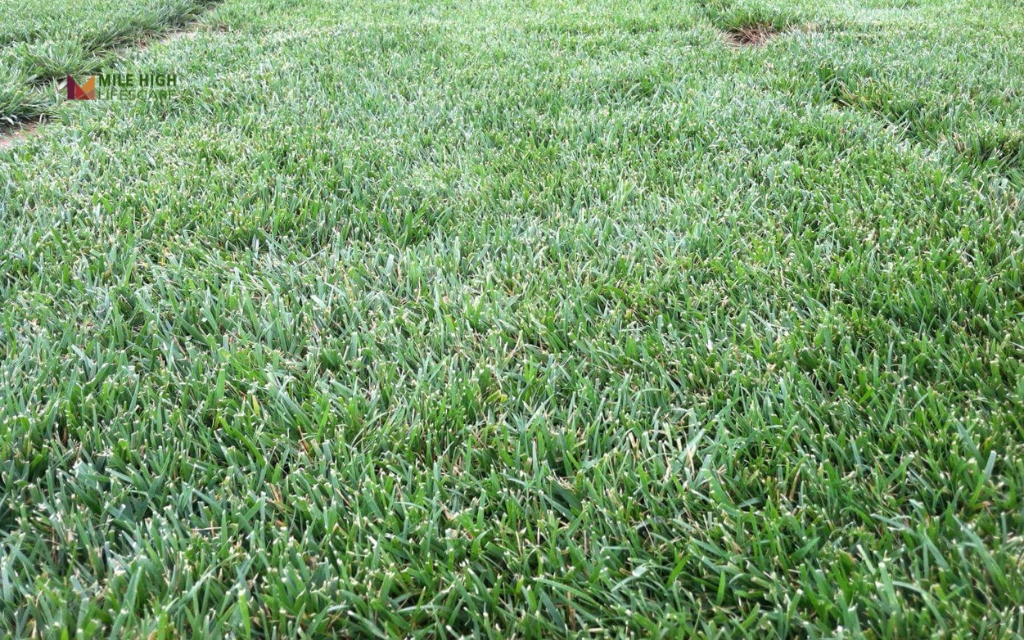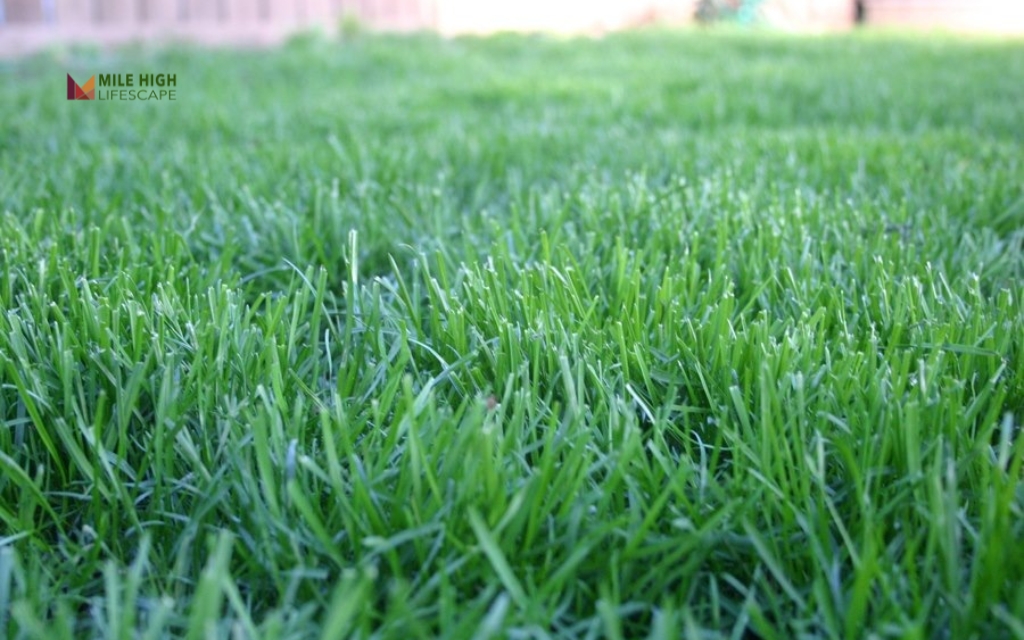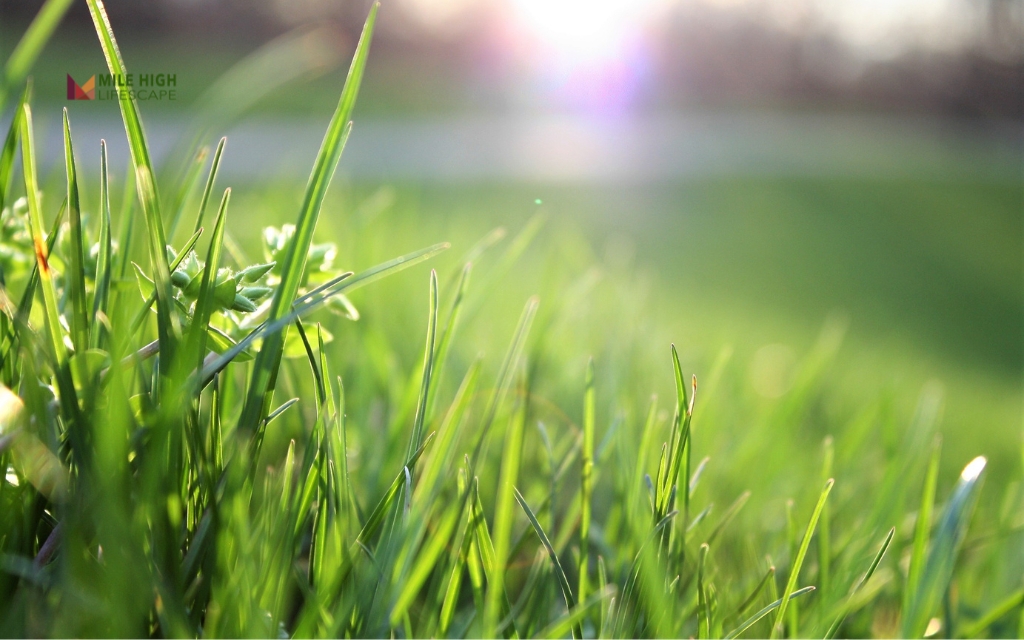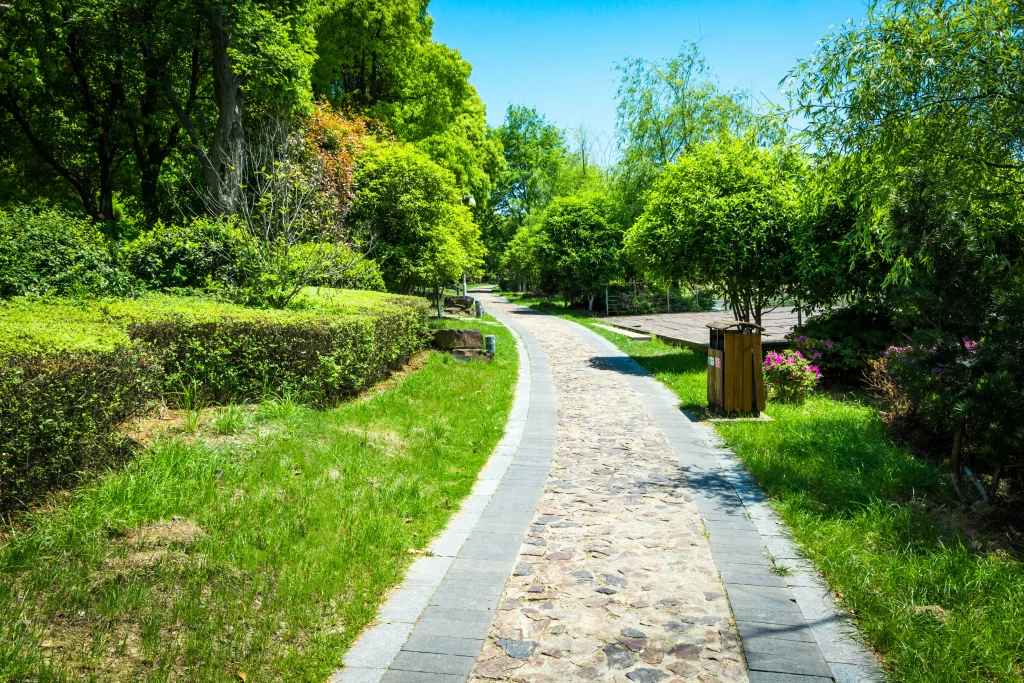When selecting grass for your Denver lawn, two varieties often top the list: Kentucky Bluegrass and Tall Fescue. Each grass type offers unique benefits that address Colorado’s challenging climate conditions.
Tall Fescue is generally considered a better option than Kentucky Bluegrass in Denver’s challenging climate with its exceptional drought resistance, lower water requirements, and minimal maintenance needs. However, Kentucky bluegrass is often favored for its attractive look and soft feel, but it does demand more upkeep and attention.
At Mile High Lifescape, we’ve installed and maintained both grass types throughout Denver and surrounding areas for almost two decades. This comparison will help you understand the strengths and limitations of each grass variety, enabling you to make an informed decision for your property.
Tall Fescue – Tough, drought-defying performer
Tall Fescue thrives as a bunch-type grass with deep roots that can extend 2-3 feet into the soil. This deep root system enables superior drought resistance, making it well-suited for Colorado’s semi-arid climate. Originally developed for livestock grazing, modern turf-type Tall Fescue varieties maintain durability while offering improved density and finer texture than earlier generations.
Tall Fescue stands out with its ability to remain green during hot summer months when other grasses typically go dormant. The grass establishes quickly from seed, typically germinating within 7-14 days, and reaches maturity faster than Kentucky Bluegrass. Its adaptability to various soil conditions, including clay-heavy soils common in Denver, makes it a practical choice for many homeowners seeking a resilient lawn that requires less intensive maintenance.

Kentucky Bluegrass – Soft, self-healing beauty
Kentucky Bluegrass creates the quintessential American lawn with its dense, carpet-like appearance and rich blue-green color. Unlike Tall Fescue, it spreads through underground rhizomes, allowing it to self-repair when damaged—a significant advantage for high-traffic areas or lawns where children and pets play regularly.
This grass type delivers superior aesthetics with its fine texture and uniform growth pattern. Kentucky Bluegrass exhibits exceptional cold tolerance, making it well-equipped to handle Colorado’s winter temperatures. However, this premium appearance comes with higher maintenance requirements, including more frequent mowing, fertilization, and watering. It performs best in full sun conditions, though some newer varieties offer improved shade tolerance. For homeowners prioritizing a showcase lawn with classic beauty, Kentucky Bluegrass represents the gold standard.

Difference Between Kentucky Bluegrass vs. Tall Fescue
Kentucky Bluegrass creates that classic, carpet-like lawn with its dense growth and rich color, while Tall Fescue provides exceptional drought tolerance and durability in our semi-arid environment. Your choice between these two popular grass types ultimately depends on your specific lawn needs, maintenance capacity, and priorities for your outdoor space.

Compare these two popular grass types at a glance to understand their key differences and determine which best suits your Denver lawn conditions and maintenance preferences.
Feature | Kentucky Bluegrass | Tall Fescue |
| Growth Pattern | Spreads via rhizomes | Bunch-type grass (limited spreading) |
| Water Requirements | High (needs regular irrigation) | Moderate to low (drought-resistant) |
| Heat Tolerance | Moderate (goes dormant in extreme heat) | High (stays green in heat) |
| Cold Tolerance | Excellent | Good |
| Shade Tolerance | Poor to moderate | Good to excellent |
| Recovery from Damage | Excellent (self-repairs) | Poor (may need overseeding) |
| Blade Texture | Fine, soft | Coarse, sturdy |
| Color | Deep blue-green | Medium to dark green |
| Establishment Time | Slow (21-28 days) | Faster (14-21 days) |
| Traffic Tolerance | Moderate | High |
| Maintenance Level | High | Moderate |
Climate Compatibility
Kentucky Bluegrass:
- Thrives in cool-season regions like Denver’s higher elevations
- Struggles during extended heat periods above 90°F
- May require dormancy protection during drought restrictions
- Performs exceptionally during spring and fall in Colorado
Tall Fescue:
- Excels in transitional climate zones
- Maintains color during Denver’s hot summers
- Handles temperature fluctuations effectively
- Better adapts to Colorado’s semi-arid conditions
For Denver’s climate specifically, Tall Fescue generally offers better year-round performance due to its heat tolerance and lower water requirements. Kentucky Bluegrass shines during our cooler months but may struggle through July and August without supplemental irrigation.
Drought and Heat Tolerance
Kentucky Bluegrass:
- Requires 1.5-2 inches of water weekly during peak summer
- Enters dormancy (turns brown) during drought conditions
- Recovers well from drought when water returns
- Often needs irrigation systems for consistent appearance
Tall Fescue:
- Needs only 1-1.5 inches of water weekly during summer
- Maintains green color during moderate drought periods
- Root system accesses deeper soil moisture
- Handles water restrictions better than most cool-season grasses
Tall Fescue clearly outperforms Kentucky Bluegrass in drought and heat tolerance—a critical factor for Denver homeowners facing water restrictions and conservation efforts. The water savings alone often makes Tall Fescue the more economical long-term option.
Disease and Pest Resistance
Kentucky Bluegrass:
- Susceptible to summer patch, necrotic ring spot, and rust
- May develop dollar spot in humid conditions
- Attracts some grub species
- Requires preventative fungicide treatments in vulnerable areas
Tall Fescue:
- Resistant to most common lawn diseases
- Less prone to insect damage
- Occasional brown patch issues during humid periods
- Generally requires fewer chemical interventions
Tall Fescue’s superior disease resistance translates to lower maintenance costs and fewer chemical treatments throughout the growing season, making it the healthier choice for many environmentally-conscious homeowners.
Maintenance & Mowing
Kentucky Bluegrass:
- Mow at 2.5-3 inches during spring/fall
- Raise to 3-3.5 inches during summer
- Requires regular fertilization (4-5 times yearly)
- Thatch management needed every 1-2 years
- Benefits from annual aeration
Tall Fescue:
- Mow at 3-4 inches year-round
- Needs less fertilizer (2-3 applications yearly)
- Minimal thatch development
- Less frequent aeration (every 2 years)
- Overseeding recommended to maintain density
Kentucky Bluegrass demands more frequent maintenance interventions than Tall Fescue, translating to higher ongoing costs and time investments. Homeowners with limited time for lawn care often prefer Tall Fescue’s more forgiving nature.
Aesthetic Appeal & Texture
Kentucky Bluegrass:
- Creates the classic “perfect lawn” appearance
- Fine blade texture feels soft underfoot
- Dense, carpet-like uniformity
- Rich blue-green color provides striking visual appeal
- Excellent for showcase front yards
Tall Fescue:
- Coarser texture but modern varieties are much improved
- Slightly less uniform appearance
- Consistent green color throughout the growing season
- Maintains appearance better during environmental stress
- Ideal for functional family spaces
Kentucky Bluegrass wins the pure aesthetics competition, creating that magazine-worthy lawn appearance. However, Tall Fescue’s ability to maintain its appearance through harsh conditions offers practical beauty for busy households.
Which is Better: Kentucky Bluegrass or Tall Fescue?
Tall fescue is typically seen as a superior choice compared to Kentucky bluegrass in Denver’s tough climate, thanks to its outstanding drought tolerance, reduced water needs, and low maintenance requirements. On the other hand, Kentucky bluegrass is popular for its appealing appearance and soft texture, although it requires more care and attention.

However, both Kentucky Bluegrass and Tall Fescue offer substantial benefits for Denver homeowners, with neither representing a universal “best” choice. Your decision should align with your specific property conditions, aesthetic preferences, water availability, and maintenance capacity. Consider these factors when making your decision:
Choose Kentucky Bluegrass if:
- Visual appearance is your top priority
- You have a full-sun yard
- You’re willing to invest in regular maintenance
- Your property has an irrigation system
- You need excellent cold tolerance
- You want a self-repairing lawn that handles foot traffic
Choose Tall Fescue if:
- Water conservation is important to you
- Your yard has partial shade areas
- You prefer lower maintenance requirements
- You need excellent heat and drought tolerance
- Your soil conditions are challenging
- You’re establishing a lawn with children and pets
Consider a Blend if:
- Your yard has varied sun/shade conditions
- You want balance between appearance and durability
- You’re looking for some self-repair capabilities with drought tolerance
- Your lawn usage changes seasonally
Many Denver homeowners achieve ideal results with specialized blends that capitalize on the strengths of both grass types while minimizing their weaknesses.
Conclusion
Kentucky Bluegrass delivers unmatched visual appeal and self-repair capabilities but demands more resources and attention. Tall Fescue offers exceptional drought tolerance and stress resistance with more modest maintenance requirements but won’t create that classic “carpet lawn” appearance.
Many Denver homeowners achieve optimal results by strategically using both grasses—Kentucky Bluegrass in showcase areas and Tall Fescue in functional spaces or challenging environments. This approach maximizes the strengths of each grass type while minimizing their limitations.
Need personalized guidance for your specific lawn conditions? Contact Mile High Lifescape for expert consultation and professional lawn care services tailored to your property’s unique needs. Our team brings nearly two decades of experience with both grass types throughout the Denver metro area.
Frequently Asked Questions (FAQs)
Can Kentucky Bluegrass and Tall Fescue be mixed together?
Yes, specialized seed blends combine these grasses to leverage the strengths of both varieties. These mixtures typically contain 70-80% Tall Fescue for drought tolerance and 20-30% Kentucky Bluegrass for self-repair capabilities. Professional turf managers often recommend these blends for Denver’s challenging climate.
How long does it take to establish each type of grass from seed?
Tall Fescue typically germinates within 7-14 days and establishes a usable lawn within 4-6 weeks. Kentucky Bluegrass takes longer, with germination occurring at 14-21 days and full establishment requiring 8-12 weeks. For faster results, consider sod installation, which provides an instant lawn regardless of variety.
Which grass type requires less water?
Tall Fescue consistently outperforms Kentucky Bluegrass in water efficiency. Its deeper root system requires approximately 30% less irrigation to maintain comparable appearance. This translates to significant water savings during Denver’s hot, dry summers and better performance during water restrictions.
Is one grass type better for families with pets?
Both grasses can work well with pets, but they offer different advantages. Kentucky Bluegrass self-repairs from damage but may show more visible urine spots. Tall Fescue resists urine damage better but requires overseeding to repair worn paths. For most families with active pets, Tall Fescue’s durability and lower maintenance typically provide the edge.
Which grass type is better for shady areas?
Tall Fescue significantly outperforms Kentucky Bluegrass in shade tolerance. While Kentucky Bluegrass requires 6-8 hours of daily sunlight, Tall Fescue can thrive with just 4 hours. For properties with mature trees or buildings creating significant shade, Tall Fescue represents the clearly superior option.
